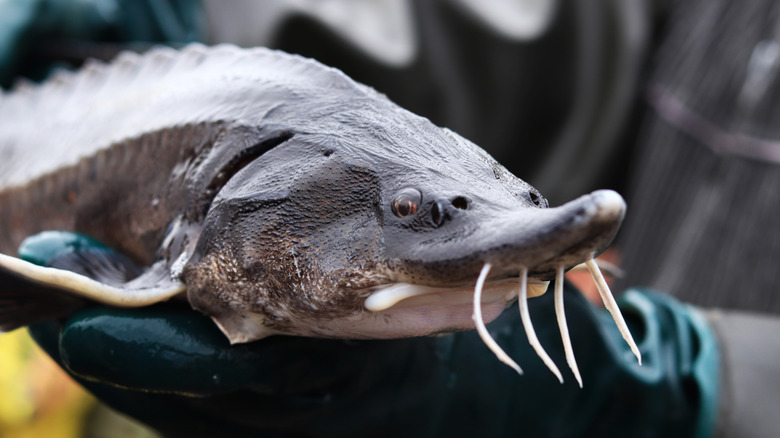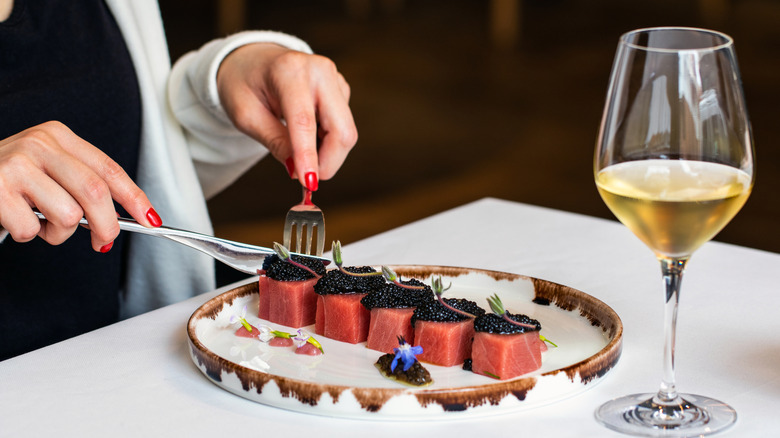Why Is Caviar So Expensive?
Caviar is one of those dishes that very quickly reminds you of how things are going with your finances. I'll never forget a few years back when I went to The Refectory, an upscale restaurant in Columbus, Ohio, and the caviar on the menu was $295 ... for like an ounce! I was shocked and genuinely perplexed at how it could cost that much for so little product. I've always known caviar to be a high-end item, but sheesh, that felt like robbery. I had no understanding of how the delicacy earned its luxury status not just from tradition, but from the sheer effort and patience it took to bring it to your plate.
We're talking about salt-cured eggs from sturgeon, which are ancient, slow-growing fish that aren't in any rush to start laying your future food. It can take a decade before one of these fish even thinks about giving up a batch of roe, and that's if the conditions are just right. And if you assume harvesting these eggs is a quick or simple process, forget about it.
Unlike other types of roe, true caviar must come from specific sturgeon species. That already narrows the supply, but on top of that, the farming or trading of these fish is tightly regulated, and the processing of the eggs must be done precisely to maintain quality. By the time it's packed and ready to go to market, the price reflects how much effort went into producing even the smallest tin.
It takes years just to get the eggs
Sturgeon are basically the tortoises of the seafood world, taking anywhere from seven to 10 years (sometimes longer) just to start producing eggs worth harvesting. So when a caviar farm invests in a school of baby sturgeon, it knows it's not getting paid anytime soon. And this waiting game involves years of feeding, filtering water, and keeping those fish calm, clean, and healthy.
Even after the sturgeon mature, egg harvesting is a delicate process. The timing has to be perfect, as the eggs can't be too soft or too firm. Once harvested, the eggs are carefully rinsed, sorted by size and color, lightly salted, and then packaged. Any misstep in handling can ruin an entire batch.
Wild-caught sturgeon used to be more common, but due to overfishing and environmental concerns, today, most caviar comes from farmed fish. Though this helps protect wild populations, it also increases the cost. Farming sturgeon requires a controlled environment, a steady supply of clean water, and regular monitoring, all of which add up over the many years it takes to raise the fish.
Supply is limited and demand is high
Caviar's high price isn't solely related to production — it's also about the market. Despite the limited supply from "true" caviar sturgeon, demand continues to grow. Strict international regulations also control how much caviar can be produced and exported, which is essential in preserving the species but also keeps the product rare. Interestingly, China produces the most caviar world-wide.
In addition, handling and transportation demands special care. Caviar is perishable and sensitive to temperature, so it has to be stored and shipped under very specific conditions (between 28 and 32 degrees Fahrenheit). This aspect also adds to the cost before it even reaches a retail shelf.
Once packaged, caviar is often sold in tiny tins that can cost hundreds of dollars depending on the type and quality of the roe. In the end, caviar's expense comes down to a mix of biology, logistics, and tradition. From the time it takes to raise a sturgeon to the careful processing and packaging of the eggs, every step proves why caviar remains one of the most expensive delicacies in the world.


